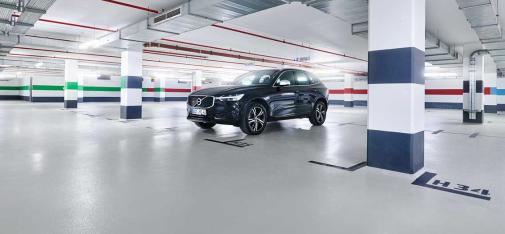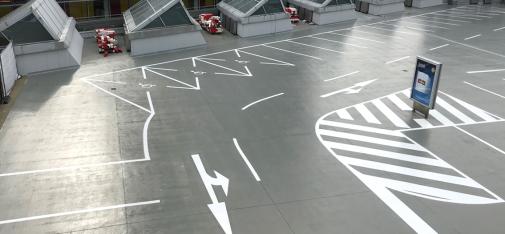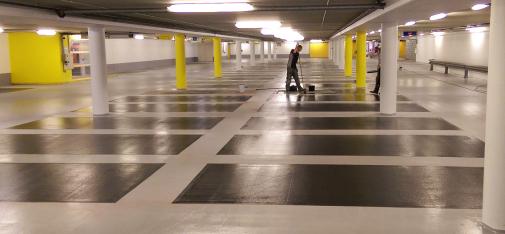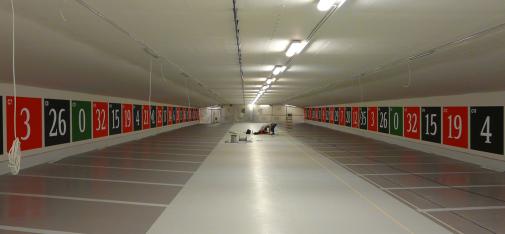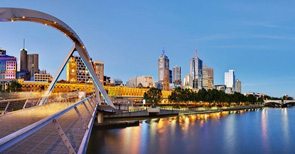-

Concrete corrosion in a multi-storey car park
MC-KKS/B ensures permanent protection
Extensive rehabilitation measures had to be carried out on a five-storey car park in Germany. Thanks to the cathodic corrosion protection provided by the unique MC-KKS/B system solution from MC-Bauchemie and Grillo-Werke AG, the damaged reinforced concrete was permanently and economically rehabilitated in its entirety without any large-scale fabric removal, thus also avoiding associated nuisances such as dust, noise and long operational delays.
MC-KKS/B stops concrete corrosion in carpark
Germany
Extensive rehabilitation measures had to be carried out on a five-storey car park in Melsungen (Hessen, Germany), with the first four storeys presenting a particular challenge. There, the structural fabric of the steel-framed concrete construction had deteriorated to such an extent that complete removal of the chloride-contaminated concrete was being seriously considered. However, thanks to the cathodic corrosion protection provided by the unique MC-KKS/B system solution from MC-Bauchemie and Grillo-Werke AG, the damaged reinforced concrete was permanently and economically rehabilitated in its entirety without any large-scale fabric removal, thus also avoiding associated nuisances such as dust, noise and long operational delays.
The free-standing multi-storey car park in Melsungen in the Schwalm-Eder district of North Hessen consists of two five-storey building sections, one new and one old. In the case of the old building, the condition of the structural fabric was found to have suffered extensive and heavy chloride and carbonation corrosion, necessitating the operator to institute thorough refurbishment.
The work began in 2019. The 2,500 m² area of the uppermost fifth parking deck had sufficient waterproofing against moisture ingress under the asphalt of the paved surface and was thus not as badly damaged. Its repair merely meant applying the PCC concrete replacement Nafufill KM 130 classic and increasing the concrete cover. A new waterproofing layer and a wearing course of mastic asphalt were then added. The expertise of MC-Bauchemie was also in demand before the welding membrane was laid: in order to ensure a permanent waterproofing that complied with current state of the art standards, the planner opted for a structure that met the strict requirements of the ZTV-Ing for bridge structures.
Special resin for waterproofing regardless of weather
In this case, the properly and professionally pre-treated substrate, which in this case was made with the PCC concrete replacement for the repair of horizontal surfaces Nafufill KM 130, must be treated with a so-called bridge resin. Usually, epoxy resin-based products are used for this purpose. However, as it is known that these can only be applied when the substrate is dry and the weather is dry for a longer period of time, the planner decided to use the MC-DUR LF 680 bridge resin from MC-Bauchemie. This special resin based on KineticBoost® technology is an innovation in the field of bridge and parking deck waterproofing, as it is the only bridge resin currently available on the market that can be applied regardless of the dew point. Even slightly damp substrates do not pose a problem. In addition, the product reacts with "top speed" within a short time. Priming, scratch filling and firing of the welding track can be done in one day. And that even if the outside and component temperature is only 2 °C. The selection of MC-DUR LF 680 ensured fast and safe construction progress despite adverse weather conditions.

© MC-Bauchemie 2025
Aggressive degrading caused by chlorides and carbonation
The renovation of the remaining four floors, each of which also measured 2,500 m², proved to be much more problematic. Here, chlorides had already penetrated the reinforced concrete structure due to a lack of any waterproofing under the asphalt. The chlorides and carbonation had caused damage to the reinforced concrete and the reinforcement after just a short time, making extensive rehabilitation an absolute necessity. If chlorides in high concentrations have penetrated through to the reinforcement and remain there over time, the damage they cause often leaves no option but to demolish the structure. To prevent this from happening, the planners SiB "Ingenieurgesellschaft mbH, Sanierung im Bauwesen" of Ober-Mörlen near Frankfurt/Main decided to apply the globally unique, patented MC-KKS/B system solution from MC-Bauchemie and Grillo-Werke AG as a means of saving the structure. Gerd Bott from MC-Bauchemie's Central Germany Service Centre, a technical adviser with extensive knowledge of the MC-KKS/B system, was on hand to advise the planners throughout the project.
Chlorides and carbonation trigger aggressive degradation processes. Once a critical concentration of chloride ions is exceeded, corrosion of the steel is inevitable. The chloride ions act as a catalyst and accelerate the corrosion process locally through pitting corrosion, a mechanism that is not visible from the outside. But it is precisely this undetected and often underestimated damage that gives rise to cost-intensive rehabilitation measures and sometimes even necessitates demolition of the structure. Hence it is imperative to identify the damage at an early stage and stop the deterioration before it is too late.
MC-KKS/B as a time-saving and economical repair option
The system of cathodic corrosion protection (CCP - German abbreviation KKS) from MC-Bauchemie and Grillo-Werke AG serves as a fast-acting and cost-effective method of refurbishing chloride-contaminated structures. Based on experience gained over a development period of almost 20 years, the MC-KKS/B system enables already damaged but still functional reinforced concrete to be repaired more economically and faster than can be achieved with conventional methods. This is because conventional repair processes invariably require the chloride-contaminated concrete to be removed to considerable depths extending beyond the steel reinforcement. This not only represents a substantial intervention in the core fabric of the structure but also a very lengthy and very expensive approach, whereas the MC-KKS/B system solution offers a largely non-destructive repair option.
The repair process
The contractor commissioned to carry out the work in Melsungen, Wiedemann & Sohn GmbH from Wiesbaden, began in 2019 to remove the asphalt on level 4 of the multi-storey car park over a deck area of around 2,500 m². To prepare the substrate for cathodic corrosion protection, only the partially loose concrete needed to be removed. These areas were duly reprofiled, with voids, cavities and spalling being rectified using a special repair mortar. The chloride-contaminated concrete was left in situ in its entirety. The repair phase also involved installation of the contact plates which would later serve to electrically connect the zinc layer and the reinforcement.
Following completion of classic substrate preparation by shot blasting, the MC-KKS/B system was applied. The zinc layer was deposited on the concrete by electric arc thermal spraying, a process that can be used not just for floor but also for wall and ceiling surfaces. Because the CCP (KKS) system was to be installed concealed under a welded membrane and asphalt for the first time in Melsungen, the specially developed, temperature-resistant 2-component epoxy resin MC-DUR LF KKS was used. This sealed the applied zinc layer and closed pores and blowholes in the substrate before the Wiedemann operatives baked on the waterproofing layer in the form of a welded membrane. Extensive tests had to be carried out in advance to ensure the viability of this process. With these trials having successfully demonstrated resistance of the MC-KKS/B system to considerable heat exposure, installation was completed to schedule and without disruption. Finally, an asphalt layer was reapplied to provide the paved surface, with a waterproofing barrier having been first installed beneath to prevent any future chloride penetration and thus preserve the reinforced concrete structure in its functionally intact state.
Time and cost advantages
The cost advantages of the system lie primarily in the elimination of the financially expensive removal of the contaminated concrete. Added to this there are the huge rehabilitation time savings that derive from installation of this system, not least because of the absence of curing periods that would otherwise have to be taken into account in a new construction involving large volumes of concrete and mortar. The system can be implemented comparatively quickly, which in turn means that the renovated asset is ready to be returned to service correspondingly faster. The reduced downtime associated with car park rehabilitation is invariably of major financial benefit. Plus there is virtually no reduction in clearance height or load-bearing capacity, as the zinc layer applied has an average thickness of just 150 µm.
Following the good experience with the refurbishment of the fourth car park level, work on level 3 was carried out in 2020 along the same lines, and from mid-June 2021 also on levels 2 and 1. Thanks to the MC-KKS/B system, therefore, the chloride-contaminated areas of the Melsungen multi-storey car were retained and provided with a new wearing layer, rather than being demolished and rebuilt. The condition of the ageing structure was thus viably re-instated, enabling the previously very dissimilar sections of the car park to grow old side by side.
-
Name
MC-KKS/B stops concrete corrosion in carpark
-
Country
Germany, 2021
-
Fields of Expertise
-
Categories
-
Products
RELATED CONTENT
-
News
Click here to go to our News section.
-
MC-Pedia
In our MC-Pedia you will find technical articles on various topics written exclusively by our specialists.
-
Magazine
Get our latest issues of our customer and employee magazine MC aktiv.
-
Downloads
Find all relevant datasheets of our products as well as brochures of our company, Fields of Expertise and product categories here.
-
References
Click here to get to our library with reference projects for all types of application.
-
Careers
Click here to go to MC Career.
-
Contact
Click here to go to our Contact section.



